Jun 11, 2021
Future of Ouchijuku’s kayabuki roofs rests in hands of skilled few
Gallery - Ouchijuku, Fukushima Prefecture
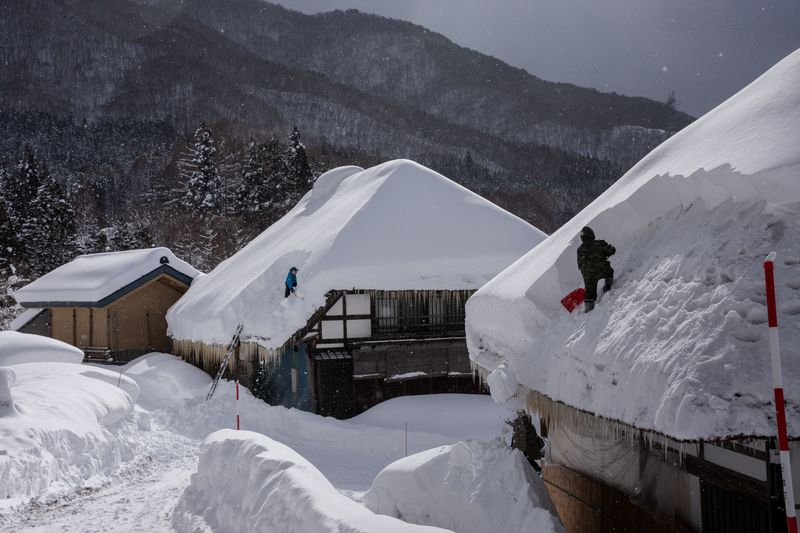
The distinctive kayabuki thatched roofs of Ouchijuku draw tourists in droves to the former post town in Fukushima Prefecture and yet the task of maintaining their glory rests in the hands of only a skilled few.
"There is no instruction manual or textbook for this. Students have to learn through experience," said Sato Takamitsu, giving a demonstration of the techniques employed in the maintenance of Ouchijuku’s kayabuki thatched roofs.
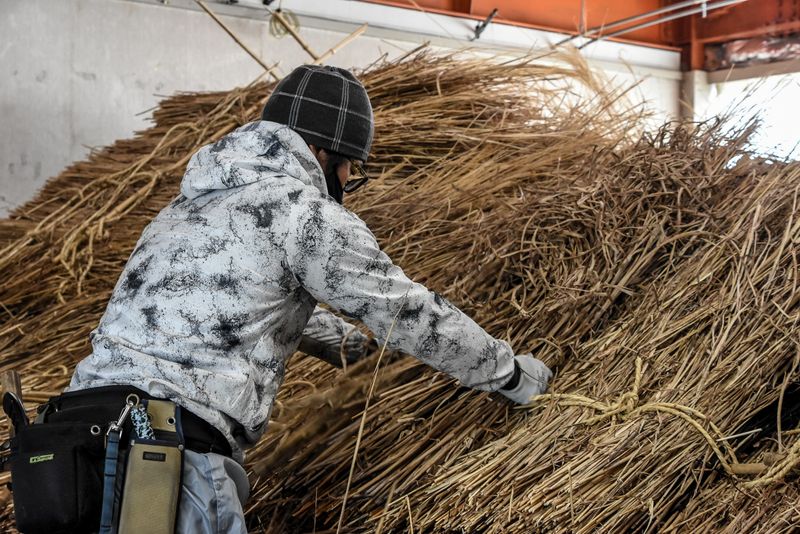
(Sato Takamitsu gives a demonstration of kayabuki thatch roofing, Ouchijuku, Fukushima Prefecture)
Ouchijuku, in the town of Shimogo in Fukushima Prefecture’s Minamiaizu District, is home to some 40 buildings, dating back around 400 years, which feature kayabuki thatch roofing. As the head of a local association formed to preserve the traditional kayabuki roofing methods used here, Takamitsu teaches the techniques he learned himself here in Ouchijuku to others.
"Now it’s time for me to pass on these skills to the next generation," he said during an interview and demonstration in Ouchijuku in February.
A lack of any formal, by-the-book approach to instruction perhaps belies the fact that these traditional skills and techniques, along with the knowledge employed by craftspersons like Takamitsu, used to restore and maintain kayabuki roofing across Japan were inscribed in 2020 on UNESCO’s Representative List of the Intangible Cultural Heritage of Humanity.
Under the heading “Traditional skills, techniques and knowledge for the conservation and transmission of wooden architecture in Japan,” UNESCO recognized techniques, like those used for kayabuki roofing, as serving “a social function by fostering cooperation and social cohesion and strengthening Japanese people’s sense of cultural identity.”
In Takamitsu’s classroom any textbooks appear to have long since gone.
Around once a month local students come to learn kayabuki roofing from Takamitsu in the classrooms of Ouchijuku’s former elementary school. Based on online records, the school appears to have closed after being merged, along with other schools in the area, in 2005 into Egawa Elementary School, a few kilometers away.
Over 15 years on and the susuki pampas grass used as material for Ouchijuku’s roofs sits in piles on the floors of classrooms still decorated with the peeling and faded fixtures and fittings of elementary school life -- chalkboards remain fixed to the walks, posters display the school song, and notice boards in the corridors outside tell of school activities.
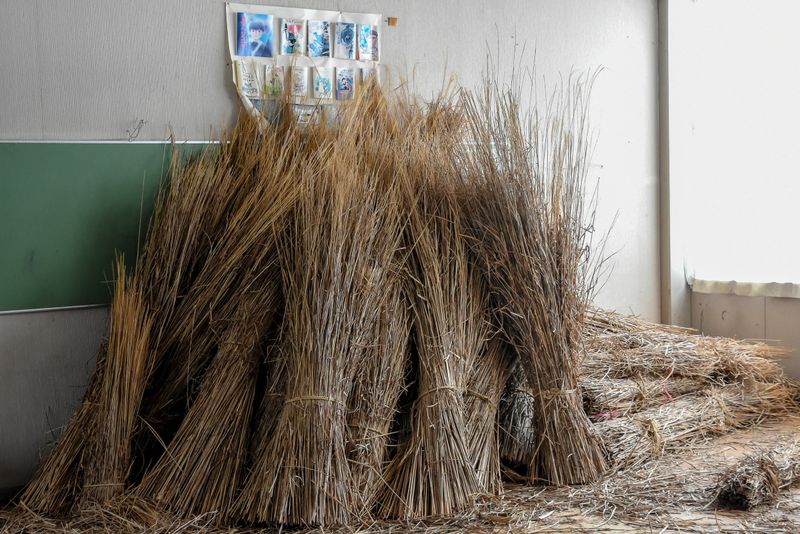
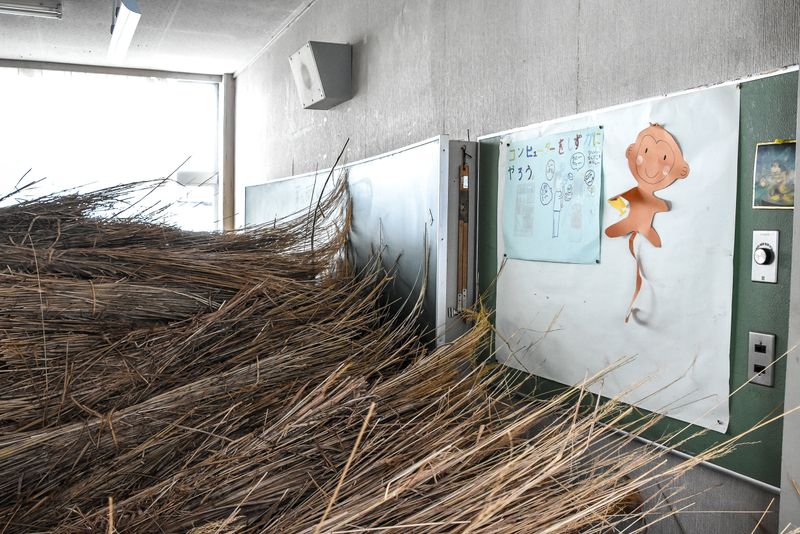
(Susuki pampass grass piled up in the classroom of a former school in Ouchijuku)
The somewhat melancholy setting for class seems a far cry from the glamor that might come with UNESCO recognition even if it does perhaps highlight the necessity for such recognition, reminding of the kind of fate that can await institutions and traditions left exposed to the unforgiving realities of depopulation and lifestyle changes.
Ouchijuku’s population, according to Takamitsu’s on-the-spot estimate, is around 200, including around 20 children up to junior high school age. According to figures published in an April 2020 report by Shimogo Town, the actual population stood at 152 in 2020, marking a decrease of over 60 percent since the late 1970s.
If Ouchijuku’s permanent population appears small, it appears even smaller in comparison to the number of annual visitors that make the journey out to this otherwise quiet corner of Japan to see the traditional townscape. In 2019 visitors numbered around 870,000, according to the Shimogo Town report. Prior to the 2011 nuclear disaster visitor numbers had topped one million for four consecutive years.
One wonders how many of the millions of visitors who have stared in wonder at Ouchijuku’s roofs have dared to contemplate in just how many hands lies the responsibility of keeping the roofs in such a state as they can continue to be enjoyed by millions more visitors in the future.
The Association for the Preservation of Traditional Roof Thatching Methods of which Takamitsu is head, has 13 members.
Seven to eight students turn up for class at the former school each month where they learn about techniques which, while broadly speaking are common to the kayabuki roofing found in other parts of Japan, have some characteristics unique to the local area most notably in the use of natural materials found in the Aizu region -- these include the susuki pampas grass occupying much of the classroom in which Takamitsu gave his demonstration.
"It’s not an ideal number (of students) but the people we are teaching now, hopefully they will teach the next generation, and not just here in Ouchijuku but in other regions, too. We need to do this because the people who have these skills are getting older and fewer,” said Takamitsu.
"People come here to see the roofs of this post town. I was born and bred here. I want to take care of this landscape and this region."
Some degree of roofing work in Ouchijuku is carried out annually between spring and autumn. At the height of winter work appears limited to shoveling the heavy snow from the roofs and, in the case of some buildings, trimming the icicles which hang from the eaves of the roof.
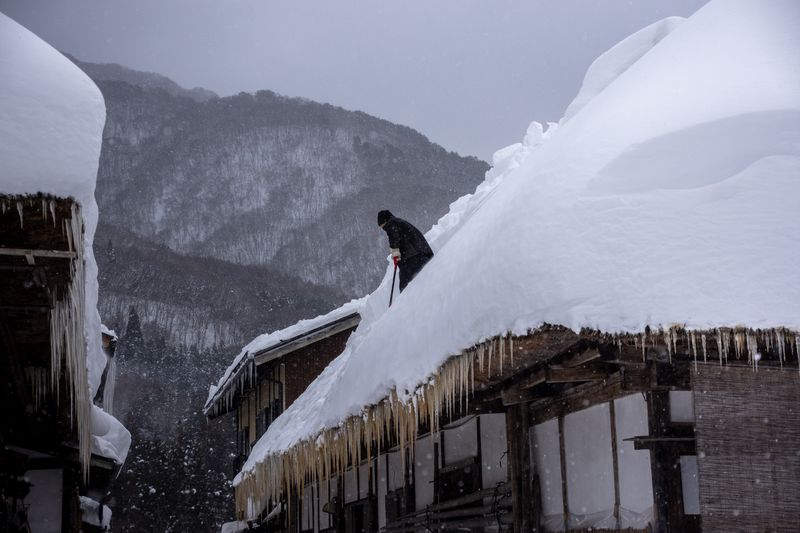
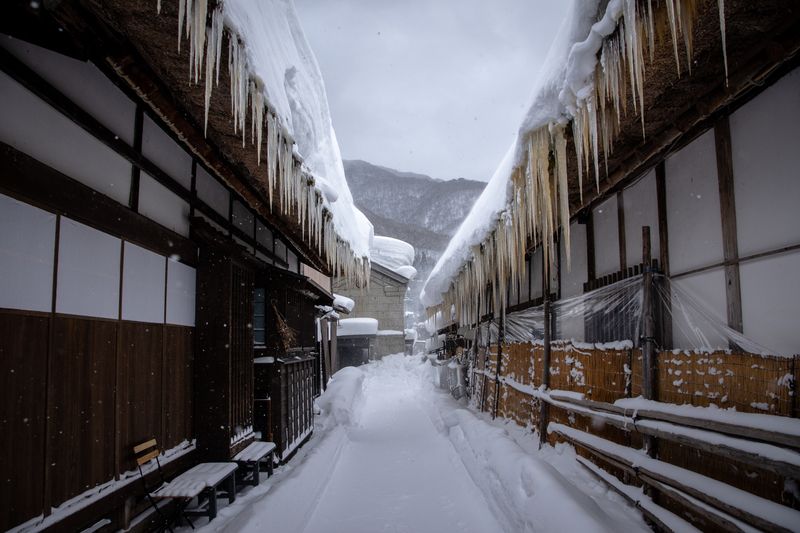
(Clearing snow off the roof / icicles, Ouchijuku - photos taken February 2021)
While kayabuki thatching helps to keep building interiors cool during the summer and warm in the winter, it is vulnerable to fire, which can spread quickly. An annual drill, held in September, draws visitors to Ouchijuku to see water projected high into the air from fire hydrants located in front of each of the houses.
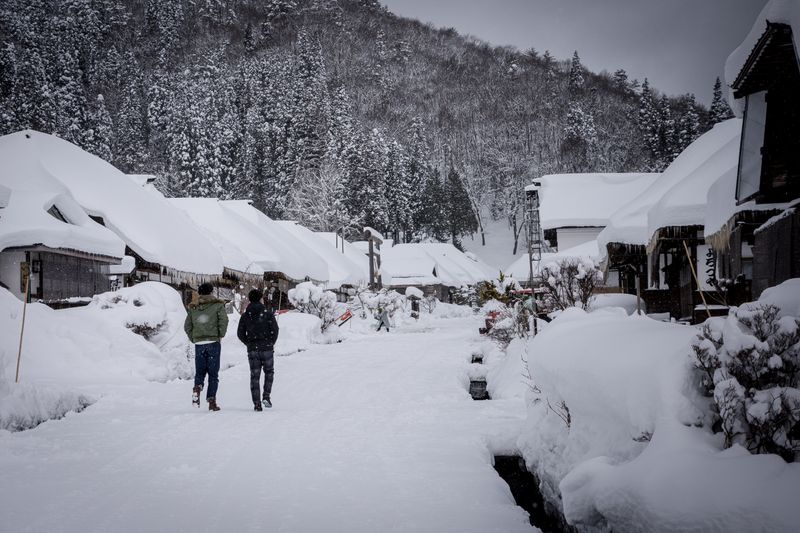
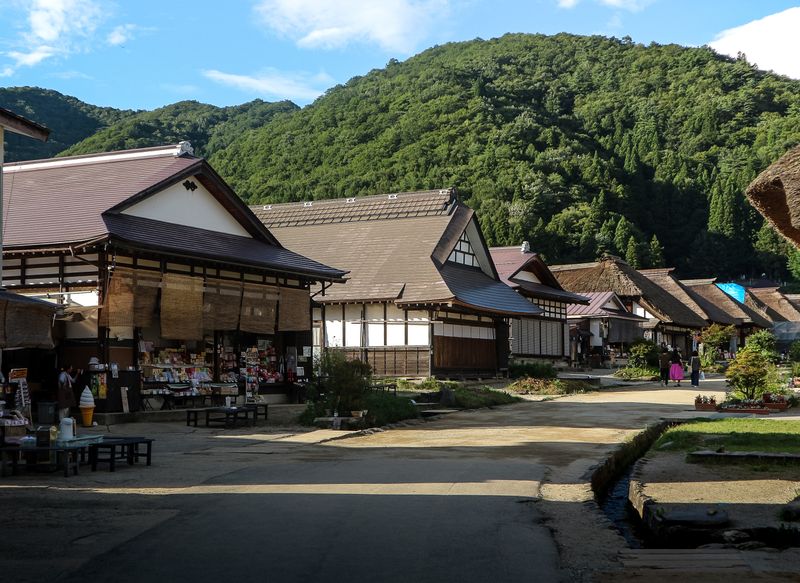
(Ouchijuku's main thoroughfare - top photo taken February 2021, bottom photo taken September 2019)
Guide to Ouchijuku
Ouchijuku is celebrated for showcasing a townscape which is said to well reflect the look and feel of things during its time as a post town of the Edo era.
Today the town sits a few kilometers west off of Route 121, the modern north-south road connecting the city of Aizuwakamatsu (to the north) with the city of Imaichi, a jump off point for the Nikko region in Tochigi Prefecture (to the south).
During its years as a post town Ouchijuku served as a stop along the Shimotsuke Kaido, a route which similarly connected what is now Aizuwakamatsu with Nikko. Approximately 130km long, the Shimotsuke Kaido was used by feudal lords on their way to and from their mandatory, every-other-year residency in Edo (present-day Tokyo) under the ruling shogunate’s sankin-kotai policy.
As much as the town might be said to have maintained its look from its days as a post town welcoming weary feudal lords, one suspects that this is mostly on the surface only.
The beautiful buildings that line the central, unpaved thoroughfare are largely home to restaurants serving local or regional fare, bohemian coffee shops, and souvenir / craft stores. Streams have been channelled on either side of the thoroughfare, marked by the occasional kawato structure -- platforms from which town residents would do their washing or collect stream water.
Visitors arriving from Tokyo will likely enter Ouchijuku from a parking area just south of the town. Looking north up the central thoroughfare, the large torii shrine gate of Takakura Shrine on the left hand side marks an approximate halfway point.
Further along from the torii and set back a little from the action is the town’s former honjin, a building which served as the principal inn for high-ranking government officials. Today the restored structure houses a museum. Records show that the first lord of the Aizu Domain, Hoshina Masayuki, stopped for lunch here while traveling with his cavalcade to or from Edo, according to information published by Shimogo Town. It is believed that the cavalcades of lords like Masayuki could have consisted of up to 600 people, contributing to the hustle and bustle of Ouchijuku in those days.
Masayuki is a hugely influential figure in the history of the Aizu region, with his policy of undying allegiance to the ruling shogunate setting the Aizu samurai on a collision course with Meiji-era reformers that would ultimately bring about their end as well as a kind of symbolic end for samurai all over Japan. The influence of Masayuki’s, and Aizu’s, loyalty to the shogunate is felt even today - in tourism circles and in political circles.
Forested mountain slopes occupy much of the northern horizon beyond Ouchijuku. At the end of town the road bends left before forking off and up toward the diminutive Shohoji temple. From the temple, steps lead further up and across the mountainside to a viewpoint overlooking the town.
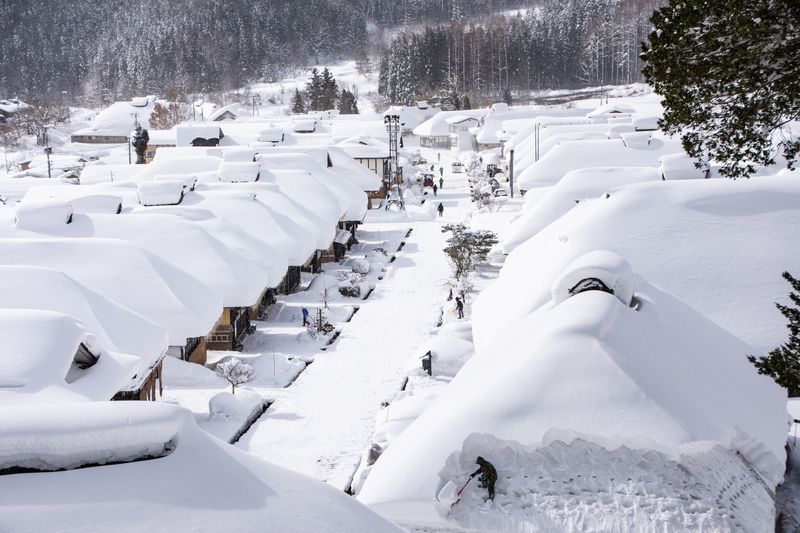
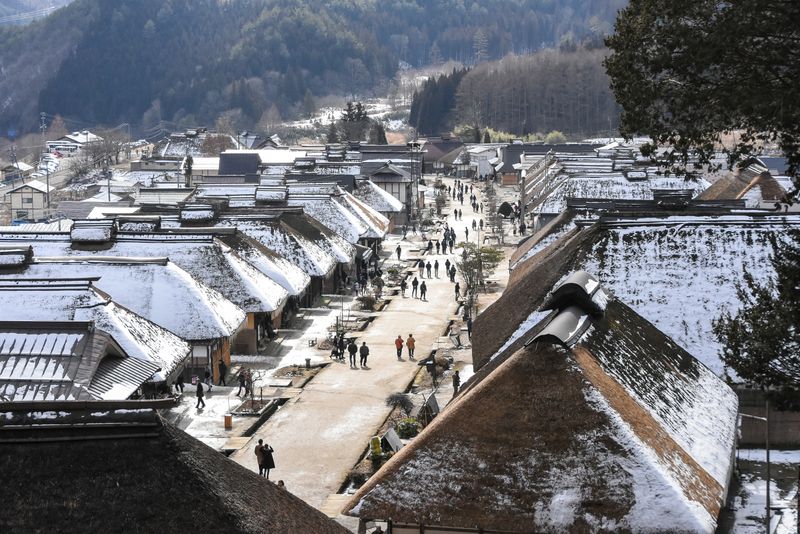
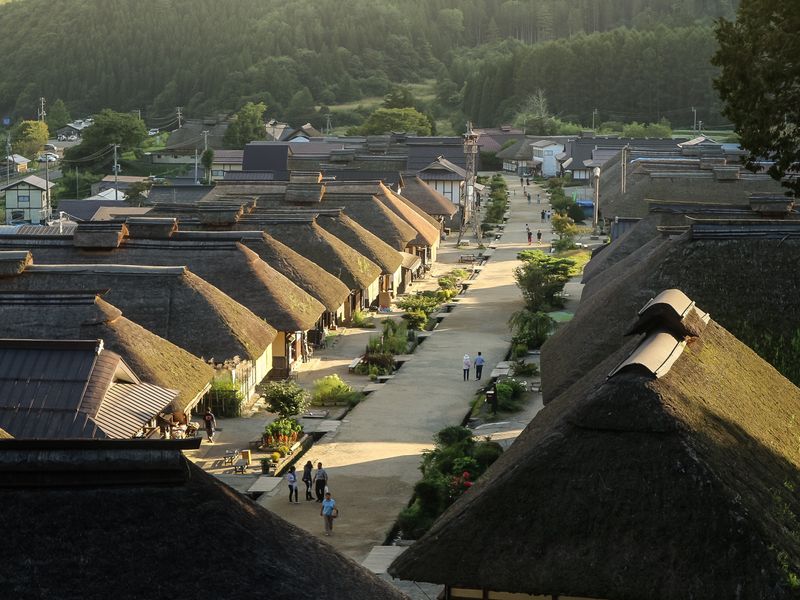
(Ouchijuku across the seasons as seen from a popular view point)
There are a few places to eat along Ouchijuku’s main strip. Takato soba is a staple on the menus here. It’s basically negi soba -- soba noodles topped with finely chopped negi, a kind of long green onion. The name is said to derive from the Takato clan of what is now Nagano Prefecture.
Don’t believe any claims that to eat like a local in Ouchijuku is to eat your dish of Takato soba using a whole negi in place of chopsticks. On the contrary, to do so marks you out as a tourist, although during the day almost everybody in Ouchijuku is a tourist.
Local restaurant Misawaya (at the southern end of town) lays claim to having started the practice some 30 years ago. It’s a novelty at best -- not only is using a negi to scoop up slippery soba noodles terribly impractical, diners will need a lead-lined stomach to consume a whole raw negi. Take a scoop and a bite or two and then switch to chop sticks.
Another local speciality of the Minamiaizu area is shingoro -- miso-coated rice balls, skewered and grilled over an open flame. Shingoro can be found on the menu at some Ouchijuku restaurants.
Related articles on City-Cost
Family of brewers pursues clean energy future for Fukushima region
Interview with a geigi: Higashiyama Onsen, Aizuwakamatsu
10th anniv. exhibition unearths symbols of hope from 2011 disaster heritage
Further afield
Adventurous travelers heading from Ouchijuku to Aizuwakamatsu can make a detour to Sakuradai Kannon.
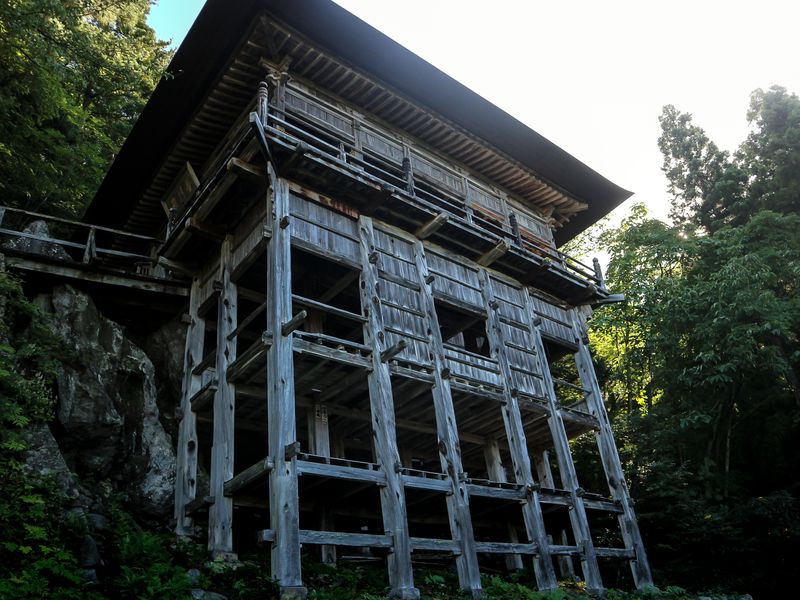
(Sakuradai Kannon, Fukushima Prefecture - photo taken September 2019)
The 21st of Aizu’s 33 Kannon pilgrimage sites, Sakuradai Kannon is said to date back to the year 830 when it was constructed as a temple built for priests training in ascetics.
Built on a steep mountain slope overlooking the Okawa River and beyond to Mt. Bandai, the temple’s construction is over 14 m tall, supported by a lattice of wooden pillars and beams.

(View to Mt. Bandai from Sakuradai Kannon, Fukushima Prefecture - photo taken September 2019)
The Kannon here is said to watch over all, ready to help when someone calls out. A smaller stone Buddha is also enshrined here -- sometimes referred to as the Kubinachi Kannon (the “No Neck Kannon”).
The Aizu 33 Kannon Pilgrimage was established by the first lord of Aizu, Hoshina Masayuki. It was a move greatly welcomed by the people of Aizu and is seen by some as efforts made by Aizu’s samurai to generate a tourist economy.
The pilgrimage remains popular today, taking in mountains and national treasures and giving pilgrims opportunity to take breaks in the old post towns and villages that flourished between the pilgrimage sites.
That said, Sakuradai Kannon is something of a remote and lonely spot for which travelers will likely need their own set of wheels to access.



0 Comments